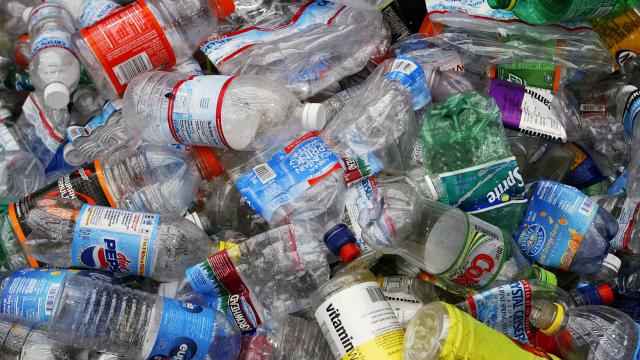There is about a tonne of plastic for each person living in the world today — that’s 8300 million tonnes of plastic produced since 1950, most of which has become waste and ended up in landfills. Even worse, plastic production is increasing and half of all the plastic on Earth was created in the past 13 years. But you can reduce your own impact by cutting back your plastic consumption. Here are eight steps you could take.
Photo by Justin Sullivan/Getty Images
Buy in Bulk
Buying in bulk reduces the amount of packaging needed for an item. Instead of buying small containers of hand soap, buy a huge container that you can refill your smaller bottles with. Even better, go for the bulk bins and buy everything using containers from home. As an added bonus, buying in bulk also reduces the number of trips you need to make to the store, and you’ll be saving money while you save the environment.
Use Reusable Shopping Bags
Instead of getting all your groceries in plastic bags every time you go shopping, bring a reusable bag. It can be as fancy as this one with a lot of pockets, or it could be something simple like an upcycled rice bag. An increasing number of retailers such as Woolworths and Coles sell (or will soon sell) reusable bags at their checkout lines, meaning there’s no excuse not to use one.
Pressure Companies to Use Less Plastic
When enough consumers become sufficiently vocal, corporations respond to their demands. Being a smart consumer and knowing about the companies you buy from is helpful. If a company does something you disagree with, email them and tweet at them to voice your outrage. Or, even better, start buying from its competitors instead.
For example, Coca-Cola produces more than 100 billion plastic bottles in the United Kingdom, which many environmentalists find concerning. An environmental group in the UK filed a complaint, urging Coca-Cola to do more to produce less waste. In response to these concerns, Coca-Cola UK announced initiatives like a program that lets people return bottles for a small refund.
Invest in Reusable Containers
Every year almost 35 billion plastic bottles end up in the bin. Instead of buying disposable plastic water bottles, invest in a reusable water bottle or thermos — preferebly one that isn’t plastic. Not only will getting a good water bottle improve your water drinking experience (your water stays cold and doesn’t form condensation on the outside), but it will also encourage you to drink more water.
When bringing lunch to work or going out to eat, bring your own utensils instead of using plastic disposable ones. The Kitchn has a roundup of their recommendations for reusable utensil sets. Also, pack your lunches with reusable Tupperware more often instead of getting a takeaway container.
Look for Alternatives in Packaging
Most of the plastic we use is for packaging, meaning that it’s only used once then thrown away or recycled. To remedy this waste, look for alternatives to plastic packaging: Buy toilet paper wrapped in paper, buy milk in glass containers that you can return, buy whole fruit at grocery stores and forgo plastic bags entirely. Larger items like avocados or apples don’t need produce bags. For smaller items such as grapes, check with your grocery stores to see if you can bring your own bags for produce instead of using the grocery store’s produce bags.
Push for a Plastic Tax/Ban
Individual actions are important, but larger actions, such as those led by the government, can spark major change. Encouraging your city governments to create laws that encourage less plastic can make a huge difference overall in plastic consumption. In the US, cities like San Francisco and Chicago have already introduced laws limiting plastic consumption. Meanwhile, some US states like New York have killed laws taxing plastic bags. In Australia, there are various movements to ban plastic bags. If you’re unhappy with plastic bag laws in your area, take it up with the local government.
Compost
Instead of using a lot of plastic bags to throw out your garbage, reduce the amount of garbage you produce by composting. You’d be surprised at how much of your garbage is actually compostable (more than half). You can buy a compost bin that does most of the work for you or make one yourself. If you’re unsure where to start, Lifehacker has a comprehensive guide to composting.
[referenced url=”https://www.lifehacker.com.au/2014/05/this-infographic-shows-what-you-can-and-cant-turn-into-compost/” thumb=”https://i.kinja-img.com/gawker-media/image/upload/t_ku-large/reinwkybuvrs9wdr8mch.jpg” title=”This Infographic Shows What You Can (And Can’t) Turn Into Compost” excerpt=”Composting is a great way of turning trash into treasure, but you may have trouble getting started. Fix has a handy infographic that tells you everything you need to know about composting.”]
Buy Secondhand
New items almost always come in plastic packaging, but you could reuse someone else’s items instead of buying new ones from a store. If you’re looking for a new toy for your child, buy it secondhand. Scope out op shops or Gumtree for things that you need such as clothes or furniture. A bonus is that it will also save you money along the way. Just be more careful when buying used technology or mattresses.

Comments